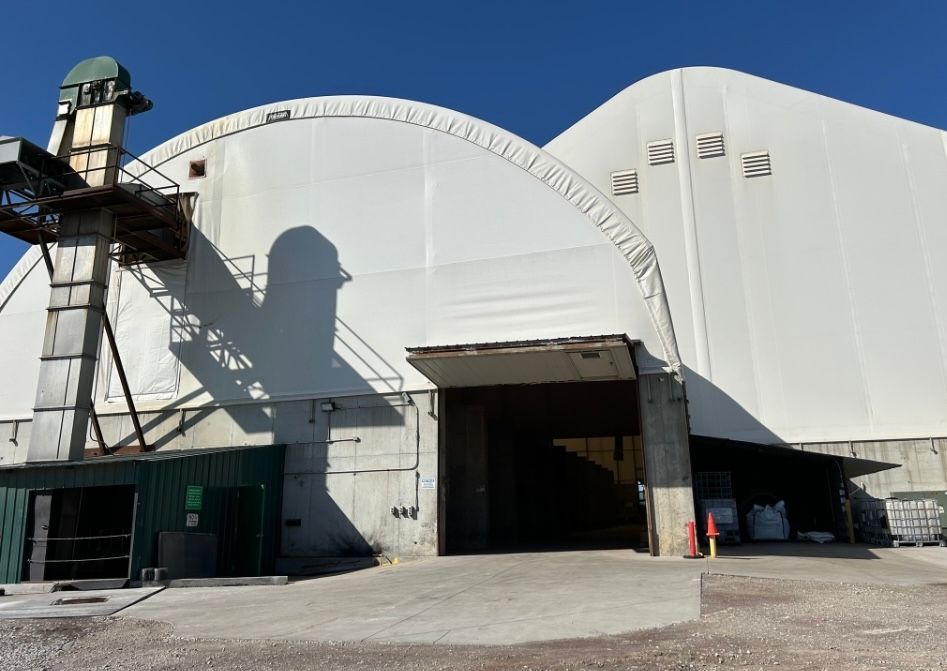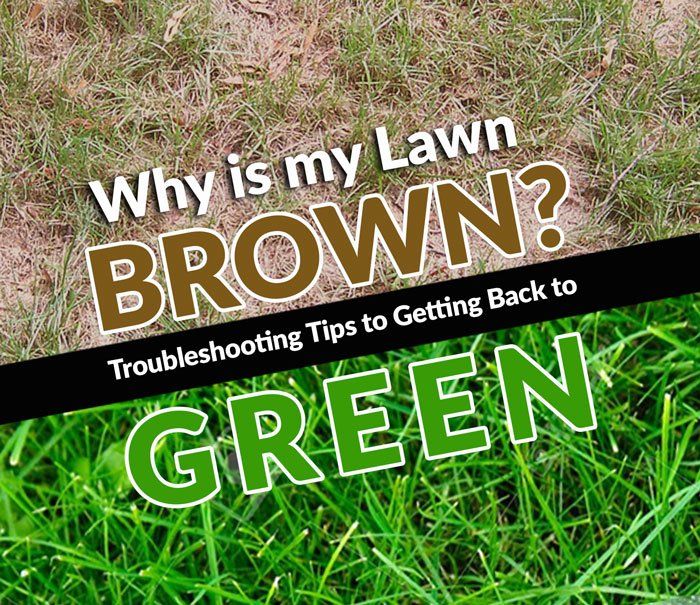TROUBLESHOOTING TIPS
Typically, grass turns brown when it's roots are too short to properly grab nutrients or water from soil or, the soil does not contain enough nutrients or water. There are multiple reasons why your lawn can be turning brown. Here are 7 common reasons why your lawn is turning brown and ways to treat them:
DROUGHT/HEAT
Turf goes dormant during periods of extreme heat and low rain/water. This is completely normal and grass will turn green on its own once the temperature drops and rain resumes. Before treating a lawn due to drought, determine if drought is leading to your brown grass by “watching for prematurely dropping trees that are folded up like they’re praying for rain (says TV host Jason Cameron, a partner with TruGreen lawn care service).” To maintain a drought-dormant lawn, apply ½ inch of water every two-three weeks during the time of the drought. If you’re interested in giving your lawn a pick me up during a drought, apply 1 inch of water weekly (every 6-7 days) to green it up.
- Note: An inch of water is about 1 hours of sprinkler use.
WEEDS
Weeds
are a culprit to brown lawns that provide competition for water and nutrients. If your lawn is overrun by common weeds and turning your grass brown, apply a pre-emergent herbicide (applied before weeds appear) in spring to prevent germination.
**Keep Updated by checking out our Weed of the Week articles on ways to prevent specific common weeds**
DISEASE
Your lawn could have a disease which is causing your grass turn brown. If you’re noticing that your lawn is covered by black, brown, red or white substances, then your lawn may be diseased. This problem should be diagnosed and treated by a lawn care specialist. Fortunately, by raising a healthy lawn through proper lawn care, such as sufficient watering in the early mornings, regular mowing, lawn aeration, and thatch management, you are more likely to prevent a lawn disease.
GRUBS
Lawn grubs, often referred to as white grubs are the soil-inhabiting, larva of beetles including: Japanese beetles or European chafers or June “bugs” beetles. These immature organisms feed on grass roots as well as other organic substance in soil, causing turf to turn brown and die. To figure out if grubs are infesting your lawn, take samples from multiple spots by cutting away one square-foot piece of turf and inspecting the roots for grubs every 2 inches. To control, let your lawn dry out before watering and depending on the stage of the infestation, apply insecticide products.
WATERING TOO MUCH
Even in the heat of summer, you should not water grass every day. Overwatering causes grass to have a short root system which makes it more susceptible to insect infestation, weeds and disease. Instead of little drinks daily, give your lawn a drink once a week to establish a deeper root system.
DOGS
Who doesn’t love these lovable, furry creatures but believe it or not your loving pet can cause brown patches in your lawn. Urine contain salts and acid that can lead to turf discoloration. The constant heavy traffic of your pet can cause wear and tear on your lawn as well. Unfortunately, there is not an effective product that can help your lawn from your loving animal but we do have a few suggestions: Water down the area where your animal recently urinated to dilute the salt and acid; create a separate area of the lawn where your animal can run, play and do their business; or create a mulched area dedicated to dog for doing their business.
DULL MOWER BLADES
Something as simple as sharpening your mower blades can prevent your lawn from turning brown. Dull mower blades will cause grass to tear instead of providing a clean cut. This causes grass bruising. Luckily, this reason for grass turning brown is easy to identify. Look at your lawns grass tips to determine if it has a clean, straight edge or if it has a torn, jagged edge. If grass tips are clean and straight, then dull mower blades are not the culprit to your brown lawn, but if you notice the torn, jagged edges, it is time to sharpen or replace your mower blades.
According to Kevin Doerfler of Grass Seed USA, some treatment and prevention tips that will help your lawn stay green are:
- Water in the early mornings to combat fungal disease. Water deeply to support a strong grass root system.
- Raise mowing height to 3 or more inches to encourage taller grass that will shade roots and reduce water loss from evaporation.
- Perform a soil test to determine improvements your lawn may need. Soil tests can be purchased form your local garden center, distributor or samples can be taken to your local extensions office.
- Adopt a healthy lawn care program, including fertilizing in spring, summer and fall.
- If necessary, call a professional lawn expert to help diagnose the problem for your brown lawn. Visit your local distributor who can help tailor a treatment method suitable for your lawn.
For professional fertilizers, humic and AMP-XC™ enriched products available, please visit TurfCare’s online Product Catalog.
For green industry professionals or others interested in ordering Turfcare products, please contact our Customer Service
to find a distributor near you.
References:
https://www.houselogic.com/by-room/yard-patio/brown-grass/
http://www.bobvila.com/slideshow/11-ways-you-re-accidentally-ruining-your-lawn-50036
Turf Care Supply - TurfReport Blog

Platte River Equity Portfolio Company Turf Care Supply, LLC Acquires Agri-Nutrients, Inc. Brunswick, OH , October 9, 2024 – Platte River Equity (“Platte River”) portfolio company Turf Care Supply, LLC (“Turf Care”) is pleased to announce its acquisition of Agri-Nutrients, Inc. (“Agri-Nutrients”), a manufacturer and blender of custom granular fertilizers for the turf & ornamental (“T&O”) industry. This strategic acquisition provides Turf Care with an established presence in the south-central United States, an enhanced product portfolio and additional manufacturing capacity. “This acquisition represents much more than a business transaction; it is a strategic step forward in expanding our reach and enhancing our customers’ growth. By bringing Agri-Nutrients into the Turf Care family, we are broadening our product portfolio, expanding our market presence and further positioning ourselves as a leader in providing innovative solutions for our customers,” said Mark Mangan, President of Turf Care. “We are excited about joining the Turf Care team,” said Jim Montgomery, President of Agri-Nutrients. “At Agri-Nutrients, our core values center around customer service and product innovation, and we are confident that this combination will allow us to better serve the needs of our customers.” “Platte River welcomes the Agri-Nutrients team to Turf Care. This transaction underscores our long-term commitment to fostering growth through both organic and inorganic initiatives across the Turf Care platform,” said Tarun Kanthety, Vice President of Platte River. “The partnership with Agri-Nutrients strengthens Turf Care’s value-added offering, creating additional growth opportunities across the combined customer base.” B&A Corporate Advisors served as the exclusive financial advisor to Agri-Nutrients. About Agri-Nutrients Founded in 1992 and based in Catoosa, OK, Agri-Nutrients is a manufacturer and blender of custom granular fertilizers for the T&O industry, predominantly selling into the lawn care, sports turf and golf course end markets. About Turf Care Supply Established in 1974, Turf Care Supply is one of the largest formulators and blenders of urea products to the T&O market. Turf Care has a comprehensive product portfolio of fertilizers, combination products (herbicide/insecticide), soil amendments and enhanced efficiency fertilizer ingredients. Turf Care's products are sold to distributors and blenders serving the commercial, residential and golf end markets. Turf Care operates four manufacturing facilities strategically located throughout the eastern U.S. About Platte River Equity Founded in 2006 and based in Denver, CO, Platte River Equity is a private equity firm focused on investments in established lower middle market operating companies within targeted industrial sectors where it has substantial operating and investing experience. Platte River utilizes prudent capital structures in order to invest in future growth opportunities and withstand changing economic environments. The firm also provides significant ongoing support to its portfolio companies through dedicated resources across functional areas. The firm has raised funds with committed capital in excess of $1.6 billion and is currently investing out of its fifth fund. The Platte River team is the largest collective investor across its funds, deeply aligning the firm with its investors and portfolio company management teams.

Dear Valued Industry Partners and Customers, We are pleased to announce that Turf Care Supply, LLC has acquired Agri-Nutrients, Inc. (October 1, 2024) a respected manufacturer in the turf and ornamental fertilizer industry. This acquisition marks a significant step forward in our commitment to providing you with an expanded range of innovative products, services, and industry expertise, all designed to support your business’s continued growth and success. As a valued partner or customer, you will benefit from enhanced service capabilities and an extended geographic reach, thanks to Agri-Nutrients, Inc.’s strategic facility located in the Port of Catoosa, Oklahoma. With this established presence in the Southwest and Western markets, Turf Care Supply, LLC’s expanded operational footprint will allow us to serve a broader region with greater efficiency, delivering even stronger support to help drive your business forward. We are dedicated to ensuring a seamless transition while maintaining the high standards of service you expect. If you have any questions or would like to explore how this new location can enhance your operations, please feel free to contact your account manager or our customer service team. Thank you for your continued trust in Turf Care Supply, LLC. We look forward to partnering with you as we grow together and continue supporting your success. Sincerely, Mark Mangan President Turf Care Supply, LLC

With a focus on providing sustainable manufacturing and reducing carbon emissions, Turf Care Supply has embraced the electric power market with the latest mobile equipment upgrades. Completed in June 2023, TCS received all deliveries of electric forklifts to all three manufacturing facilities, including Hatfield, MA, Martins Ferry, OH and Sebring, FL.

